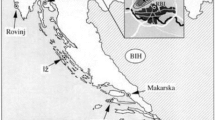Abstract
Long-term changes in total ozone time series for Arosa, Belsk, Boulder and Sapporo stations are examined. For each station we analyze time series of the following statistical characteristics of the distribution of daily ozone data: seasonal mean, standard deviation, maximum and minimum of total daily ozone values for all seasons. The iterative statistical model is proposed to estimate trends and long-term changes in the statistical distribution of the daily total ozone data. The trends are calculated for the period 1980–2003. We observe lessening of negative trends in the seasonal means as compared to those calculated by WMO for 1980–2000. We discuss a possibility of a change of the distribution shape of ozone daily data using the Kolmogorov-Smirnov test and comparing trend values in the seasonal mean, standard deviation, maximum and minimum time series for the selected stations and seasons. The distribution shift toward lower values without a change in the distribution shape is suggested with the following exceptions: the spreading of the distribution toward lower values for Belsk during winter and no decisive result for Sapporo and Boulder in summer.
Similar content being viewed by others
References
Cleveland, W.S., 1979: “Robust locally weighted regression and smoothing scatterplots”, J. Amer. Statist. Ass. 74, 829–836.
Harris, J.M., S.J. Oltmans, P.P. Tans, R.D. Evans and D.L. Quincy, 2001: “A new method for describing long-term changes in total ozone”, Geophys. Res. Lett. 28, 4535–4538.
Kerr, J.B., and C.T. McElroy, 1993: “Evidence for for large upward trends of ultraviolet-B radiation linked to ozone depletion”, Science 262, 1032–1034.
Krzyścin, J.W., 2004: “On the recovery of ozone over the NH midlatitudes: Statistical analyses of the long-term ozone measurements at Arosa”. In: C. Zerefos (ed.), Proc. XX Quadrennial Ozone Symposium, 1–8 June 2004, Kos, Greece, pp. 382-383.
Krzyścin, J.W., J. Jarosławski and B. Rajewska, 2005: “Beginning of the ozone recovery over Europe? Analysis of the total ozone data from the ground-based observations, 1964–2004”, Annales Geophysicae 23, 1685–1695.
Newchurch, M.J., E.S. Yang, D.M. Cunnold, G.C. Reinsel, J.M. Zawodny, and J.M. Russell III, 2003: “Evidence for slowdown in stratospheric ozone loss: First stage of ozone recovery”, J. Geophys. Res. 108, D16, 4507, doi: 10.1029/2003JD003471.
Reinsel, G.C., E.C. Weatherhead, G.C. Tiao, A.J. Miller, R.M. Nagatani, D.J. Wuebbles and L.E. Flynn, 2002: “On detection of turnaround and recovery in trend for ozone”, J. Geophys. Res. 107, D10, doi: 10.1029/2001JD000500.
WMO (World Meteorological Organization), 1999: Scientific Assessment of Ozone Depletion: 1998. Global Ozone Research and Monitoring Project, Report No. 44, Geneva, Switzerland.
WMO (World Meteorological Organization), 2003: Scientific Assessment of Ozone Depletion: 2002. Global Ozone Research and Monitoring Project, Report No. 47, Geneva, Switzerland.
Author information
Authors and Affiliations
Rights and permissions
About this article
Cite this article
Białek, M. Long-term changes (1980–2003) in total ozone time series over Northern Hemisphere midlatitudes. Acta Geophys. 54, 60–70 (2006). https://doi.org/10.2478/s11600-006-0006-y
Received:
Accepted:
Issue Date:
DOI: https://doi.org/10.2478/s11600-006-0006-y




